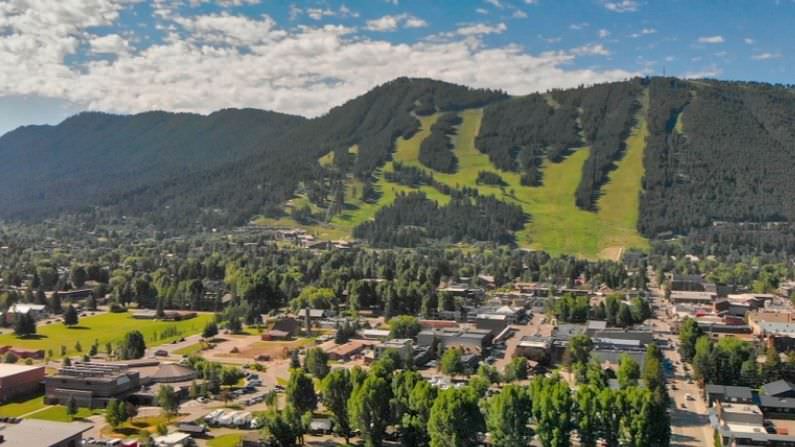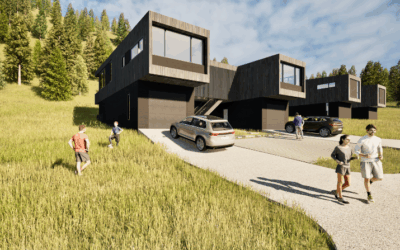Reporter’s Note: There are many more nuggets of information from the Regional Housing Needs Assessment that could not make it into this story. I encourage interested readers to take a look at the study themselves for an even deeper look into the area’s housing crisis. The following story is a brief overview highlighting some of the main data points I found most important.
5,300. That’s the number of housing units needed in the Teton Region–defined as Teton County, Wyoming, Teton County, Idaho, and Northern Lincoln County, Wyoming–to address the current crisis of affordability for local residents. It’s a mammoth problem that’s been here for a long time, but it’s also gotten much worse since the pandemic began.
Wendy Sullivan works for WSW Consulting, and she presented the Regional Housing Needs Assessment to Wyoming and Idaho elected officials Monday.
“Housing prices are up a lot. Housing supply can’t get much lower,” Sullivan said. “And then housing costs too much for the majority of people making their living in the region.”
Sullivan provided mountains of data supporting what a lot of folks already know: If you earn your money locally, buying a home is likely out of reach. Take the purchasing market. The assessment found that someone who makes $60,000 a year would need to make eight times that amount to afford the median price of a home sold in 2021.
“Of the incomes of residents and employees in the region, we see that about 81% of your households earn under 200% of the area median income. When we compare that to for-sale listings, we see that 83% of current for-sale listings are priced for households earning over 200%,” Sullivan said. “This just illustrates the imbalance.”
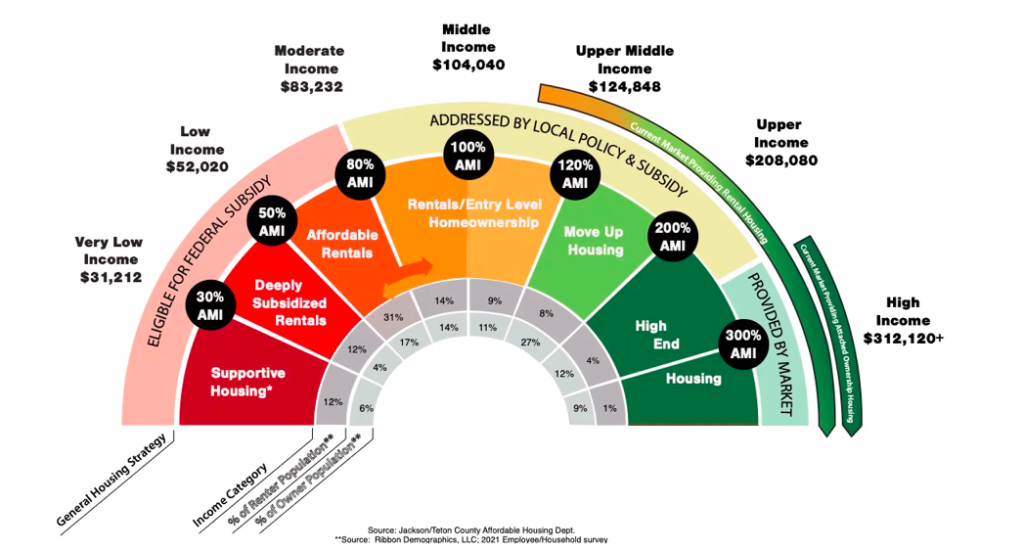
Currently, the housing market only serves folks making a high annual median income (AMI). 83% percent of listings in the Teton Region are only affordable for those making over about $200,000 a year. (Screenshot courtesy of the Regional Housing Needs Assessment)
Rental rates are increasing slightly slower, but they’re still up at faster rates than the wages in the area. A total of about 3,500 people from Teton County, Wyoming, Teton County, Idaho and Northern Lincoln County, Wyoming, were surveyed for the assessment. Of the renters studied, almost half had to move twice in the past three years, often due to price increases.
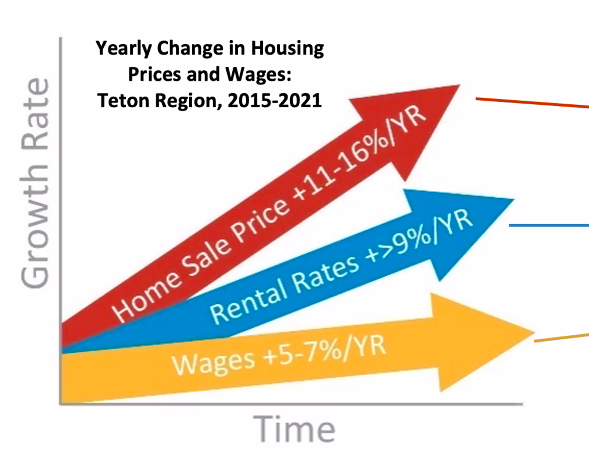
Wage growth in Teton County, Wyoming, Teton County, Idaho, and Northern Lincoln County, Wyoming, has not kept up with rental and home sale rates. (Screenshot courtesy of the Regional Housing Needs Assessment)
“All of these areas are pretty much pretty close to a 0% vacancy rate, meaning that people looking to come to your area or to fill jobs just can’t find a unit,” Sullivan said. “Those who want to or need to move to a different unit can’t do the same, either.”
Those in the main industry in town, tourism and hospitality, are not even close to making enough to compete with demand from remote workers and out-of-town retirees. Enter the region’s twin crisis: A major labor shortage. Sullivan said jobs in the Teton Region have grown at more than double the rate of housing units since 2010.
“You’re sitting at about 15-19% of your jobs being unfilled, which is huge. This is something that has been there for a while, but it has definitely been exacerbated,” she said. “By being understaffed, about a third of your businesses have reduced hours or services. This includes essential services, as well as being able to get your coffee around the corner.”
80% of employers surveyed said housing is their primary obstacle to recruiting new workers. And while these trends are most acute in the Town of Jackson, the problems have already expanded to historically commuter communities and are creating new issues there. 13% of Teton County, Wyoming, workers come from over the pass in Teton County, Idaho, and 9% come from Lincoln County.
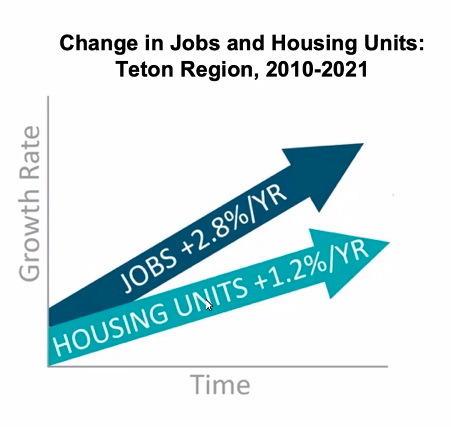
A significant percentage of jobs in the area remain unfilled in large part because units where workers can afford to live are difficult to find. (Screenshot courtesy of the Regional Housing Needs Assessment)
“That’s about 5,500 employees total commuting, and this equates to about 75 million vehicle miles traveled per year,” Sullivan said. “So, obviously, those are impacts on ecosystems, on the environment. And each of these households are spending anywhere from $6,000-10,000 per year just to commute.”
Despite their staggering nature, the study’s findings appeared sadly unsurprising to elected officials. Now, the question is what can they do about it. We know the number of units needed–again, 5,300–but who’s going to build them, and how? Sullivan said significant government investment, not just private development, is necessary to offset the high cost of building here.
“Just adding volume is not necessarily the affordable prices you need for people making their living there because of that demand imbalance,” she said. “A lot of those volumes will go to owners outside of your area. So, this means that when you’re focusing, you need to look not only on volume, but also on price point and type of product and who it is you’re specifically serving.”
But that’s a daunting task to say the least. The Regional Housing Needs Assessment shows that in order for a unit to remain affordable for people earning local wages, the community would need to invest around $500,000. Some quick math tallies the price tag to fix the region’s housing crisis at more than $2.2 billion, 25 years of the entire annual budget of Teton County, Wyoming, and the Town of Jackson.
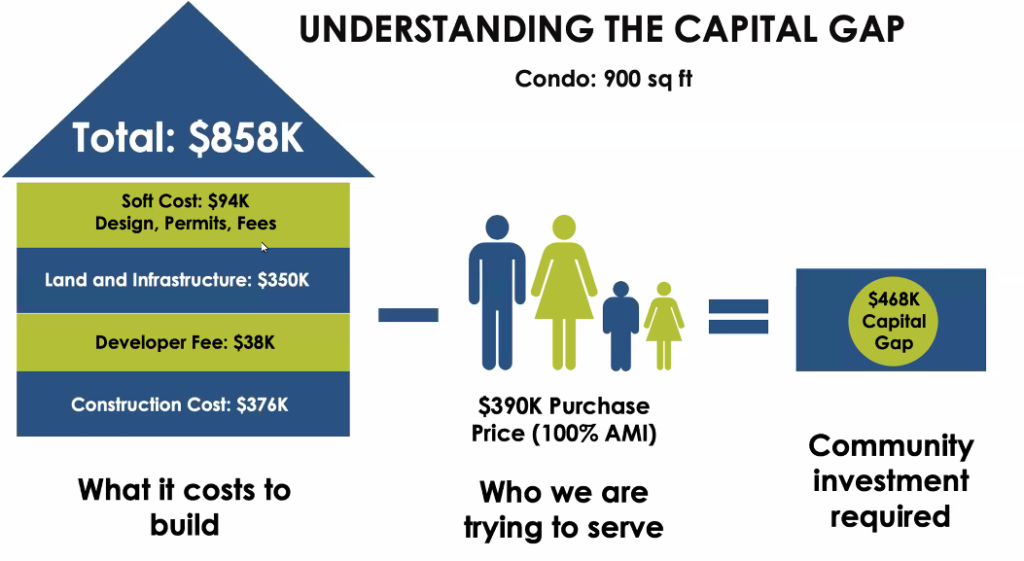
Massive government investments would be needed to bridge the gap between current market forces and affordability for local workers. (Screenshot courtesy of the Regional Housing Needs Assessment)
But Willa Williford, another consultant who worked on the project, said it doesn’t all have to fall on government officials. Raising wages, lowering construction costs and private-public partnerships can also help.
“There’s a lot of the things we try to do to make the gap smaller,” Williford said. “And then there’s also just the nut we need to crack around bringing more funds and more capital to serve the people we want.”
Williford also said there needs to be more regional collaboration from the various local housing authorities.
“Teton [County], Wyoming, is very much poised as the large job center, the population center and the longest-standing player in the housing game, [and therefore] should be a leader in that space,” she said. “We’re all about growing funding and capacity. We know it takes a lot of talented people to get this work done, and it takes a lot of financial resources to close those gaps.”
For now, at least the community is armed with more data–230 pages of it. Another housing study specific to Teton County, Wyoming is also expected to come out in April, and officials hope to start creating an action plan as soon as this summer.
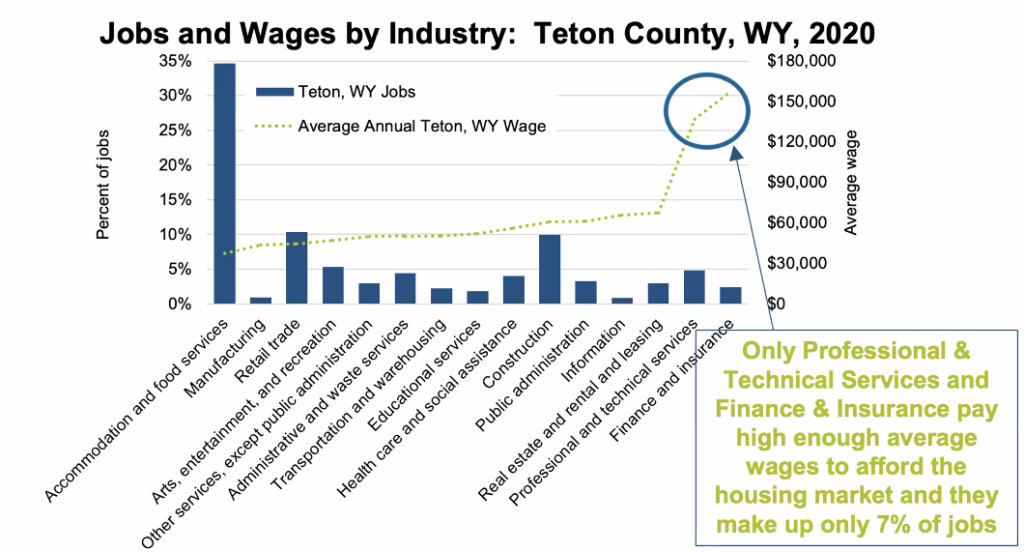
Officials say 3,500 units are needed in the next few years to better serve the bulk of the workforce in the Teton Region. (Screenshot courtesy of the Regional Housing Needs Assessment)

